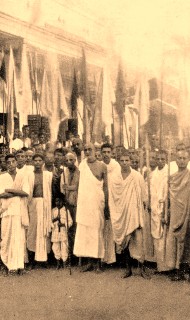Podcast
Download by “right-click and save content”
The post Positive Thinking 29 – See the invisible, feel the intangible, achieve the impossible appeared first on The Spiritual Scientist.
Websites from the ISKCON Universe
Podcast
Download by “right-click and save content”
The post Positive Thinking 29 – See the invisible, feel the intangible, achieve the impossible appeared first on The Spiritual Scientist.
For those who might wonder, the lounge will be open this Thursday, December 31. As always, the lounge will open by 7pm and will stay open as long as you’d like it to.
Brijabasi SpiritDecember 2015 |
||||||||
|
||||||||
|
||||||||
|
||||||||
|
|
|
|
After some thought I have decided to revamp my blog appearance, it has been a while several years since the last time this happened and I hope that those who read my blog will find it easier and more pleasing to the eyes.
Several changes:
1; The reading area has a lighter background and a more concise font so should make it easier to read
2; I’ve reduced the links to just a few, they haven’t been updated since the last revamp so most have gone
3; A more clearer break between each article, the share links remain
Over the past few month’s I’ve also had a long period of reflection; rejection especially from a committee whom you’ve never met directly decided your unsuitable along with a statement that one felt my blog was anti-ISKCON. Closely followed by the further insult of removing my closest friend from the mentorship system even though they have guided helped and kept me focused for many, many years even encouraging me to give class more regular and increase seva; was a pill too painful.
It has taken a huge toll and there is some area’s of seva I’ve still not returned to, despite many encouraging words from the department head; it has however focused my mind on the very few direct talks with my Guru Maharaja
My Guru Maharaja asked me many years before initiation to use my job to help those whom I care for to become Krishna Conscious; then several years later after a severe chastisement he made me promise that I would read all of Srila Prabhupada’s books three times.
So my thought’s are this have I actually remained faithful to these two requests?
I was reminded that Srila Prabhupada’s Guru Maharaja asked him to print books and to spread Krishna Consciousness to the west; he kept this always in his mind, it took a while before it became a physical reality. But his focus was to fulfil his Guru Mahraja’s request and this is a fine example to follow.
I often ponder this thought.
Although on some level’s I’m already fulfilling my own Guru Maharaja’s request in the back of my mind their remains some doubt could I be personally doing more?
Is it time to re-asses and set some new targets, increase what I’m doing keeping them realistic they are as follows:
1; Re-read the whole Srimad Bhagavatam in the coming year
2; Increase the number of community group’s I work with exploring Krishna Consciousness and studying Srila Prabhupada’s books
Their has also been another thing on my mind, I’ve been pondering that Srila Prabhupada when asked why we opened centre’s simply said that they are hospital’s for those who are wanting to be cured form the disease of material life.
So my next target is;
1; to rent one of the local community hall’s and start a Sunday Feast program
2; next year’s Diwali celebrations aim to hold in one of the local theatre’s
However I know that I will need some help on this one
I also made the discussion to come out of the mentorship system and it is as if a huge weight has been lifted off my shoulders; and I can now return back to the main and most important thing my progression in Krishna Consciousness and to share the joy of devotional life with those who cross my path.
I hope that one day I can truly say that with the help of Sri Guru, Gauranga and the loving devotees that the request my Guru Maharaja made of me that I fulfil in it’s entirety.
Hare Krishna

Recipe - Eggless Plum Cake (9 min video)
Each person has their own list of ‘must have’ foods for Christmas. The most common among all is this Fruit Cake; that wonderful combination of nuts and dried fruits with barely enough cake batter to hold it all together. If you have ever made a Fruit Cake you know that what really sets this cake apart is how we repeatedly feed the cake, over time.
It is jammed with raisins, currants, dried cranberries, dried figs and prunes, dried apricots, and candied fruit and peel (candied fruit is preserved fruit that has been dipped several times in a concentrated sugar syrup). Nuts are also included as is ground almonds.
Watch it here: https://goo.gl/jsGWT8

Harinama and book distribution in Tel Aviv, Israel (Album with photos)
Even in Tel Aviv there is a cold winter but the devotees nevertheless went out and performed the Sankirtan Yajna!
Find them here: https://goo.gl/n1yqCa

Book distributers during the December marathon (Album with photos)
Simply by watching these heroic devotees approaching the condintioned souls and benedicting them with the gift of one or more of Srila Prabhupada’s books is purifying!
Find them here: https://goo.gl/LsLhvZ

Living what you believe (video)
Mahatma prabhu is giving practical instructions about how to apply your knowledge in every day life. Because just having understood something without actually applying it doesn’t produce complete benefit.

TOVP: Progress on the chatris (Album with photos)
Sadbhuja Das: We are working in such a way that we may cover many areas of the finishing work simultaneously, few of which have commenced as you have been able to see in the previous updates.
The TOVP has a total of 8 chatris on top of the staircases surrounding the temple.
Find them here: https://goo.gl/0w5GaQ
Answer Podcast
Download by “right-click and save content”
The post How can scripture be understood relevantly without deviant interpretations? appeared first on The Spiritual Scientist.
Answer Podcast
Download by “right-click and save content”
The post Why are we unable to apply what we hear? appeared first on The Spiritual Scientist.
Answer Podcast
Download by “right-click and save content”
The post How can spiritual wisdom be introduced in academic curricula? appeared first on The Spiritual Scientist.
Answer Podcast
Download by “right-click and save content”
The post Is it because scripture’s message is spiritual that we don’t find it interesting? appeared first on The Spiritual Scientist.
I was hearing one of your lecture on the Positive Thinking series, where you talk about freewill.
It occurred to me that one of the strong arguments for humans having freewill is the presence of intelligence. If we accept that humans have intelligence then it necessarily follows that they have freewill. One of the functions of intelligence is to evaluate and make choices, which is not possible without the presence of freewill. Is this correlation correct?
Answer Podcast
Download by “right-click and save content”
The post Does our capacity for intelligence prove the reality of our free will? appeared first on The Spiritual Scientist.
The post Remorsefulness and the challenges facing introducing civilised conduct between men and women appeared first on SivaramaSwami.com.

The potency of Prasadam…
In one lecture Prabhupada talked about prasadam, and afterwards one of the devotees asked, “Prabhupada, is it true that if you take prasadam even once you’re guaranteed a human birth?” Prabhupada said, “Yes,” and all the “devotees said, “Hooray!” We were thinking, “Wow, we’ve got it made. We’ve got a human birth coming, and that’s all we have to think about.” But Prabhupada became grave and didn’t say anything for a few seconds. Then he said, “But there are some species of monkeys that are considered human.” We all had to think about that for a while and get serious.”
Excerpt From: Siddhanta das. “Memories: Anecdotes of a Modern-Day Saint Vol 4.” iBooks.
 By Srila Bhaktisiddhanta Sarasvati Thakura
By Srila Bhaktisiddhanta Sarasvati Thakura 1. Sri Caitanya Mahaprabhu’s instructions in Sikastakam, “param vijayate Sri-Krishna -Sankirtanam” is the only motto of the Gaudiya math. 2. The Supreme Personality of Godhead Sri Krishna is the only enjoyer. Everyone and everything else is the object of his enjoyment. 3. Anyone who does not serve Hari, the Supreme Personality of Godhead, is ignorant and a killer himself. 4. To learn to tolerate is one of the most important responsibilities of those living in the math. 5. Rupanuga devotees offer all glory to the original source instead of depending on their own strength. 6. Those who perform assorted religious activities can not serve the Supreme Personality of Godhead. 7. Become united with one purpose and serve Hari. 8. Where there is discussion about Hari, that is a place of pilgrimage. 9. We are not pious, sinful or learned or ignorant, we are the carriers of the dust of the feet of the Supreme Lord Sri Hari and we are initiated by the mantra “kirtaniyah sada harih.” 10. My advice is, do not criticize others. Try to rectify yourself. 11. Our supreme duty is to serve the residents of Vraja who are afflicated by Krishna ‘s departure to Mathura. 12. A pure devotee knows that everyone is the spiritual master. Therefore, a pure devotee can be jagad-guru. Continue reading "Quotes from Srila Bhaktisiddhanta Sarasvati Thakura
→ Dandavats"
 By Giriraj Swami
By Giriraj Swami Srila Prabhupada told us that Srila Bhaktisiddhanta Sarasvati Thakura was a ray of Visnu, a liberated soul sent by Krsna. He took birth in the material world for a divine purpose, specifically to assist Srila Bhaktivinoda Thakura in his work and to carry on his mission. Soon after Srila Bhaktisiddhanta's birth, during the Ratha-yatra, the chariot stopped in front of Srila Bhaktivinoda Thakura's house, and Bhaktisiddhanta Sarasvati's mother took him onto the chariot; and a garland from Lord Jagannatha fell directly onto the baby--blessings. Later, as a preacher, Srila Bhaktisiddhanta Sarasvati Thakura was a great innovator, and seeing the way he conducted his missionary activities, we can better appreciate the line in which Srila Prabhupada is coming, how Srila Prabhupada is really continuing in the same spirit as his guru maharaja. Srila Bhaktisiddhanta Sarasvati Thakura taught that one must engage in bhagavata-marga and pancaratriki-vidhi at the same time. Continue reading "Srila Bhaktisiddhanta Sarasvati Thakura’s Disappearance Day
→ Dandavats"
 By James Cooper
By James Cooper In 1786 Sir William Jones, a Welsh philologist and judge of the supreme court of Bengal, sent shock waves throughout Europe with the following speech he gave in his address to the Asiatic society of Bengal. “The Sanskrit language, whatever be its antiquity, is of a wonderful structure; more perfect than the Greek, more copious than Latin, and more exquisitely refined than either, yet bearing to both a stronger affinity, both in the roots of verbs and the forms of grammar, than could possibly have been produced by accident; so strong indeed, that no philologer could examine them all three, without believing them to have sprung from some common source, which, perhaps, no longer exists ”. The Sanskrit language contains some 2012 dhatus, which are word roots, these create the numerous dhatu rupas, which are word formations, which make up the Sanskrit language. Sanskrit can be likened to a lego set which contains some 2012 building blocks, from which one can create innumerable formations. The shock waves which rippled throughout Christian Europe with the discovery of Sanskrit, was the realisation that these dhatus, these Sanskrit word roots were riddled throughout the European languages. Continue reading "Sanskrit, Latin And Greek: is there a relation between them?
→ Dandavats"

December 28. ISKCON 50 – S.Prabhupada Daily Meditations.
The Swami was fearless. He was convinced that his message was relevant and had to be spoken. It was his show; he was in control, but he had to protect himself, especially in the beginning. It was not that the devotees were completely ready to be on his side, so he had to control the whole thing and say, “Don’t disturb, don’t disturb.” He depended on Krishna as he went on speaking the difficult-to-understand philosophy – concepts of Bhagavad-gita and the assertion that Krishna is God. He just went right ahead without watering it down in the least. You couldn’t understand it all, but you stayed and listened to him. You caught a word here and there: “Caitanya, Krishna.” Missed a word here and there. We did not understand very much of it.
Read the entire article here: http://www.dandavats.com/?p=20490&page=3
The post Daily Darshan : December 28th, 2015 appeared first on Mayapur.com.
Answer Podcast
Download by “right-click and save content”
The post If a devotee feels depressed does that mean they are not chanting properly? appeared first on The Spiritual Scientist.
15.12.2015_H.H.Prabhodanand Sarawati Swami
Answer Podcast
Download by “right-click and save content”
The post Which is the abode for sakhya rasa? appeared first on The Spiritual Scientist.
The Ramayana features many intriguing group dynamics, among human groups, monkey groups, demon groups and even human-monkey groups. Divisive and cohesive forces are graphically evident in the group of monkeys that had gone south in search of Sita.
The search and the schism
The back-story is that Rama and Sugriva had formed an alliance: Rama would help Sugriva regain his wife and kingdom, and Sugriva would help Rama regain Sita. Rama had done his part, and the now-enthroned monkey monarch Sugriva had started doing his part. He had organized his leading monkeys into four groups and instructed them to go in the four directions to search for Sita. The search parties were asked to return within a month with latecomers liable to severe punishment. Among the groups, the south-bound group was most likely to locate Sita – Ravana, the demon-king who had abducted Sita, had been seen carrying her southwards. This group had as leaders three great monkey generals: Angada, Hanuman and Jambavan. Rama gave Hanuman a signet that he was to show to Sita on finding her; the signet would assure her that its bearer was an authorized messenger of Rama.
The south-bound group searched vigorously for over six weeks, braving many dangers, but couldn’t find any clue to Sita’s whereabouts. And amidst the consequent disappointment, concealed tensions within the group came to the fore. The group’s three leaders had different things to commend them: age, lineage and grace. By age, Jambavan was the senior-most and was accorded due deference. But his age had decreased his physical prowess. By lineage, Angada was a valiant prince, being the son of the previous monkey monarch, Vali. But he was young, impetuous and inexperienced. By grace, Hanuman had received from the gods many extraordinary powers. But those powers had made him, when he was still a mischievous child, into an innocent menace for forest sages. So, those sages had cursed him to forget his powers till he was reminded of them at a later, more opportune moment. Being thus forgetful, Hanuman hadn’t, till this point in the Ramayana, done anything extraordinarily heroic.
Their search for Sita having drawn a blank, the disheartened monkeys discussed their next strategy: Should they keep searching? Or should they return, report their failure and seek further orders? Their predicament triggered residual suspicions in Angada. He said that Sugriva’s hunger for power, which had made him conspire to kill his own brother, would also make him pounce on any pretext to kill his nephew. And their delay in returning would serve as such a pretext. Angada concluded that fasting to death in the forest would be better than returning only to be executed in disgrace in front of their loved ones.
On hearing Angada’s apprehension, the monkeys responded variously, discussing to and fro, till they split into two groups. One group agreed with Angada and resolved to fast to death. The other group sided with Hanuman, who underscored Sugriva’s fairness and assured that no one would be penalized for the delay.
Seismic fault-lines in relationships
Were Angada’s doubts about Sugriva justified? Yes and no. Sugriva had undoubtedly arranged for killing Vali. But he had done so not because he craved power, but because Vali had left him with no alternative. Vali had blown out of proportion an unfortunate misunderstanding with Sugriva. Without giving his brother any chance for clarifying things, Vali had driven him to the forest, stripping him of all royal status and taking his brother’s wife for himself. Worse still, Vali had chased Sugriva far and wide with murderous intent. He had relented only when Sugriva sought refuge near a hermitage that Vali couldn’t approach due to a sage’s curse. Sugriva had tried repeatedly to reconcile with Vali, but Vali had instead rebuffed, rebuked and threatened him. Seeing no other way to guarantee his life and regain his family, Sugriva had felt constrained to arrange for Vali’s death.
Significantly, Vali had before his death reconciled with Sugriva, seeking his forgiveness and requesting him to treat Tara (Vali’s wife) and Angada kindly. Moreover, Vali had requested Tara and Angada to stay under Sugriva’s shelter and serve him as they had served Vali earlier. So the animosity between the two brothers had been fully dissolved before Vali’s death.
Even after gaining the kingdom, Sugriva had shown no glee. Quite the opposite. Vali’s death had filled him with such deep remorse that he had desired to enter the funeral pyre with his brother’s corpse. He had been dissuaded only by the words of his well-wishers, Rama and Lakshmana, who had reminded him of, among other things, his duty to his citizens. After reluctantly ascending the throne, Sugriva had carefully honored his dying brother’s request by being consistently considerate towards Angada. Moreover, presently, Sugriva had sent them on a mission to serve Rama. And that virtuous prince would certainly not have allowed anyone, leave alone the prince, to be executed because of an unavoidable delay in returning.
Unfortunately, none of these mitigating factors could allay Angada’s suspicions, disheartened as he was at their unfruitful search. Nor could he consider clarifying things with Sugriva. Instead, he chose unilaterally the extreme measure of suicidal self-mortification.
It’s revealing that Angada’s suspicions came to the fore when their mission met with a reversal that bordered on failure. The mind often magnifies problems. The Bhagavad-gita (06.06) cautions that our mind is presently our enemy. One of the ways it acts inimically is by distorting our perception – sometimes it trivializes big problems and sometimes it magnifies small problems. Sometimes, when faced with one big problem, it becomes so pessimistic and paranoid as to imagine other problems to be bigger than what they are. Thus do minor tensions in relationships get escalated.
Relationships are often so subtle and multi-level that some small tensions can exist even in the closest relationships. But the mind transforms these tensions into seismic fault-lines that, if unresolved, can give rise to a relationship-shattering quake.
A predator turns benefactor
Hanuman and Jambavan found themselves in a delicate situation. Angada, their prince and heir apparent, was leading the monkeys to mass suicide. Moreover, he was voicing serious accusations against their king. Still, they exhibited maturity in not going off the handle and counter-accusing him of treason. They understood that his words came from a hurting heart – he was still a youth, a bereaved son who had unexpectedly lost his father just a few months ago and had yet taken resolutely the leadership responsibility entrusted him. Despite his present actions, he had many praiseworthy attributes. So, with gentle words and sound arguments, they tried to make him see reason. But, despite their best efforts, they couldn’t make any headway.
Often when we do the best we can, God helps us to do what we can’t. And his help may well come in the least expected ways – sometimes in ways that don’t look like help at all. For the arguing monkeys, divine help came in a scary form.
While the monkeys’ talks had come to an impasse, suddenly a giant vulture emerged from a nearby cave. On beholding the monkeys sitting in a posture meant for fasting till death, he declared that he would soon feast on these monkeys.
Angada saw this giant bird’s appearance as providence’s punishment for his failing to serve Rama’s purpose. Seeing this vulture reminded Angada of another vulture, Jatayu, who had died while trying in vain to stop Ravana from kidnapping Sita. The despondent prince mentioned to a neighboring monkey that in their service to Rama, they seemed fated to die unsuccessfully, as had the heroic Jatayu.
On hearing the mention of Jatayu, the vulture froze. Recovering after a few moments, he asked about Jatayu, stating that he was Sampati, Jatayu’s older brother.
Relieved and intrigued, Angada told the story of how Jatayu had attained martyrdom while trying to stop Ravana from abducting Sita. Sampati cried in agony and anger, lamenting that he hadn’t been able to protect Jatayu and couldn’t even avenge his death because he no longer had wings.
Sensing the monkeys hearing sympathetically, he told how he had lost his wings. Long ago, the two bird-brothers had in their youthful impetuosity decided to fly till the sun. When the sun’s heat started scorching them, Sampati had shaded Jatayu with his wings. As his wings had burnt to ashes, he had become separated from Jatayu. He had then fallen to the earth, wingless and unable to search for Jatayu. While he had been grieving, a sage named Chandrama had solaced him with timeless spiritual knowledge and assured him that his adversity would give him an opportunity to serve the Lord who would descend in future.
Angada sensing that the far-flying Sampati might know the location of Ravana’s kingdom asked him accordingly. Perking up at these words, Sampati excitedly realized that his destined opportunity had arrived: The monkeys were servants of Rama. Further, by helping Rama’s servants in finding Ravana, he could contribute to the cause of avenging Jatayu.
He told them that several months ago, he had seen a beautiful woman carried southward through the sky by Ravana. Drawing himself to his full height, Sampati told the monkeys that despite his age, he still had keen sight. Focusing his sight on the far side across the ocean, he reported to the monkeys that Sita was there in Ravana’s kingdom, Lanka.
The monkeys became elated on learning Sita’s whereabouts. Their mutual differences forgotten, the two groups of monkeys jubilantly embraced and started planning their next move. Angada too put aside his suspicions. He had always wanted to serve Rama and hadn’t abandoned his devotion to Rama, even when doubts about Sugriva had overwhelmed him. Now that an avenue to succeed in his service to Rama had opened, he was able to push back his doubts about Sugriva.
After this incident, Angada never doubted Sugriva. In the climactic war, he fought faithfully under Sugriva, heroically felling many dreadful demons. And the other monkeys too never mentioned Angada’s accusations. Leaving the past behind them, they worked unitedly and successfully in Rama’s service.
A big problem solved through a bigger problem
The specifics of this story may not seem relevant to us when we in our daily lives face divisive tensions. But if we look beyond the specifics of the narrative to generic patterns, we can discern four stages that may well resonate with our experience:
1. A group of strong individuals come together for a challenging cause.
2. A reversal aggravates underlying tensions, creating a schism.
3. A bigger problem appears, bringing the group together.
4. In working unitedly, the group tackles the bigger problem along with the original problem.
The turning point for the monkeys was an incidental, distress-triggered reference to Jatayu. Significantly, their comparing themselves with Jatayu revealed that they were still committed to Rama. And that casual expression of their devotion turned out to be life-saving and mission-saving. Hearing Jatayu’s name, Sampati turned from predator to benefactor and told Sita’s whereabouts.
Still, even that turning point had initially looked like a worsening point. Sampati hadn’t seemed god-sent; he had seemed like devil-sent, being bent on devouring the monkeys. But despite appearances, behind the scenes, things were moving by divine arrangement to assist them. And when they persevered, that assistance manifested.
When we face problems while serving the Lord, we can’t know when and how a turning point may come. Even if things seem grim, we never lose till we lose hope. And even if we lose hope, our Lord doesn’t. He can work in the most inconceivable ways to give us hope and direction.
While we work together, as we often need to for achieving anything big, differences of opinion are inevitable. Focusing on the cause that brings us together rather than the factors that push us apart is vital for the group’s success or even survival. If we can voluntarily maintain this focus, that is the best. But if we somehow lose focus, problems seem to balloon. They compel us to choose between correcting course by uniting around the common cause or being ripped apart by the problem and the consequent exacerbated divisive forces.
The best common cause is the cause of devotion to God, for he is the well-wisher of everyone, as the Bhagavad-gita (05.29) states. And he engages those devoted to him as agents of his wisdom, helping them find their way through obstacles.
Interactions and inner actions
Successful teamwork rests on not just the interactions between individuals but also the inner actions within the individuals’ minds. This is seen from how Angada’s internal suspicion caused external dissension. Pertinently, devotion can unify us not only with others, but also with ourselves. That is, devotion can unite our present consciousness with our pure consciousness as spiritual beings, parts of God.
We have a lower side that prods us towards shortsighted actions. And we have a higher side that inspires us towards nobler, farsighted actions that are truer to our essential nature and core values. Devotion activates and strengthens our higher side, gradually elevating and uniting our self-conception with our spiritual self.
However, our lower side tends to minimize devotion, making us believe that worldly exigencies are far more important and urgent than any spiritual cause. And as such exigencies keep coming, one after another, they leave us spiritually disoriented and de-centered. Thus, we become vulnerable to divisive influences that aggravate worldly exigencies, thereby trapping us in a circle of spiritual distraction and worldly obsession. To avoid this trap, we need to use our intelligence, sharpened by regular study of scripture, to keep our devotion at the center of our heart and our relationships.
When we keep ourselves devotionally grounded, we get the inner security to act maturely in outer relationships. We can firmly resist unwarranted suspicions and non-confrontationally resolve warranted concerns. And adversities that could rupture unity can instead strengthen it if we see those adversities as spurs for focusing on God and the common cause of serving him.
The post Unity – within and without appeared first on The Spiritual Scientist.
Gita verse-by-verse study Podcast
Download by “right-click and save content”
The post Gita 08.03 – Spirituality is our nature appeared first on The Spiritual Scientist.
Podcast
Download by “right-click and save content”
The post Bhagavatam study 21 – 1.5.23-32 – Narada boy progresses towards enlightenment appeared first on The Spiritual Scientist.
Talk to Bhagavata Vidyapeetha Students at Govardhana Eco-village, Wada
Download by “right-click and save content”
The post Using jnana in bhakti appeared first on The Spiritual Scientist.
Answer Podcast
Download by “right-click and save content”
The post When we are speaking at some other organization’s forum, should we adjust or speak the truth? appeared first on The Spiritual Scientist.
Answer Podcast
Download by “right-click and save content”
The post While sympathizing with outsiders, how to ensure that insiders dont become like outsiders? appeared first on The Spiritual Scientist.
Answer Podcast
Download by “right-click and save content”
The post What were the most striking experiences of your US preaching tour? appeared first on The Spiritual Scientist.
Podcast
Download by “right-click and save content”
The post Positive Thinking 28 – Let gratitude energize you appeared first on The Spiritual Scientist.
Answer Podcast
Download by “right-click and save content”
The post How can we be sympathetic to people whose beliefs differ from scripture? appeared first on The Spiritual Scientist.
Today’s huge THANK YOU must go to one of my oldest and dearest friends Chris Foreman aka Chrissy Boy from Madness.
Chris has been a tower of strength in my life for as long as I have known him and is one of thee most compassionate people I have ever met. Thank you so much for sponsoring this trip to Calais our Chris, you have helped us to turn what was a Mission Impossible to a Mission Possible and fully accomplished.
It’s harsh out there at this time of year and in general, it is a hell on earth for the people residing in this place.
Food For All team managed to offer approx 1,000 people a hot healthy vegetarian meal with fruits, cakes and biscuits, we were also able to supply much needed wood to assist with cooking in the camp and heating but so much more is needed.
This short film will show you how much more needs to be done to assist them as this is not going to go away anytime soon.
Monday’s ‘From Cally to Calais’ team were Food For All Director Parasuram, Matchless Gifts Manager Jennie Matthias, assistants Giordani Di Napoli and Elise. Things we that these people are in dire need of are pots and pans, firewood, wellington boots, gloves and warm socks. For our part Food for All can supply the manpower, time, energy, enthusiasm, food, and some warm clothing. It takes finance to get us out there so if you or anyone you know wishes to sponsor the next trip to Calais then PLEASE PLEASE PLEASE get in touch with us and let us know…
THANK YOU to everyone involved in making this one happen.
Hare Krishna
Jennie Matthias
Anti ISKCON, or Anti people leaving ISKCON?
The other day I was challenged regarding aspects of ISKCON and it’s initiation requirements, the question was posed isn’t this making business you only give initiation if you have money right; they explained their perception if ISKCON.
Sometimes the pill is hard to swallow, but the question I asked myself is am I personally willing to listen to another point of view. However the person also had a head start they had read my own blog and knew that their was some personal fundamental thoughts from my own background.
Their view was simply this, that if we make a set of parameters and make courses a fundamental basis for initiation; then charge for the courses then we have made business of Krishna Consciousness, something our founder Acharia Srila Prabhupada spoke against.
They had also costed out resources, which was my founding argument; any logical mathematician will find it hard to justify. Followed by the cost to the devotees giving class, to which the reply was “I see they have made business out of preaching, isn’t that against the founder Acharia’s instructions?”
Again what to say, perception and when you have a charge connected with initiation then logic dictates that you leave yourself open to this accusation, and sadly I found it hard to argue against this or come up with a logical explanation.
Why?
Background and tradition; I grew up in a different background and tradition.
Baptism
This is fundamental to many Christian traditions, indeed is a requirement in many; and what’s the cost, for most it’s a zero cost.
Indeed my Jehovah’s Witness background, when I was a teenager I got baptised, back then we had to pay for all the books; however; one we didn’t that was the study book for baptism, the cost of the book was wavered. Then to study it, this was done by the elders, each one came to my home spent time covering each chapter; total cost to me zero. Them they came back with a decision on my suitability based on my answers, understanding and house to house service record; yes standardisation but note the zero cost.
Years later I spent time with a wonderful lay-preacher who set up his own church and indeed it was the most successful in the area; he hadn’t gone to any theologian collage, passed any exams but had been moved by the preaching of a baptist minister and under his direction started a church.
Again the fundamental basis was baptism, he had a six week course that anyone wanting to be baptised had to attend; cost zero, course material and books were provided free this included a leather bound bible. The baptism was performed free, then you had the option of giving something to the church but this was left to personal conscious. Most couldn’t pay as it was in a socially deprived area most were on benefits.
Their fundamental argument was based on the fact that the original devotees actually paid zero pence for initiation, did zero courses but like many lay-preacher’s were so moved by Srila Prabhupada’s words that they simply surrendered; and this for them is what is the main thing are the individual’s fully surrendered to the process of Krishna Consciousness and that they felt this couldn’t be measured in any course.
Actions speak louder than words, if your fully convinced then your actions will show, you will preach and share love of Krishna and this cannot be quantified but through personal relationship.
Indeed in both examples of baptism given there is a personal relationship, alongside standards to make sure individual’s were ready and not making a show of baptism; but in reality only Sri Krishna can know the true nature of the heart.
So given the background it’s hard to say that initiation hasn’t turned into a business transaction.
However of note is that of book distribution; it’s universally agreeable that there is some charge or donation made; this from a devotee point of view a loving exchange.
Is this a contradiction?
Again it’s down to prospective and understanding, but universally it’s agreed that if you want a book there is a charge and most are comfortable with this; indeed Srila Prabhupada reminded us and encouraged books, as we can talk philosophy and instantly one forgets but reading a book one can remember or refer back.
I’m just saddened to see so many people who come into contact leave, realistically I know not all will remain although personally I wish they did; but each time I ask the same question why did they leave and could we have done more to accommodate and encourage.
Srila Prabhupada wanted our temples and centre’s to be hospitals for all to be cured from the disease of material life, the cure for all is the same the shelter of Sri Krishna in the form of his holy names; then we have the four protective regulative principles. One who is serious and desires initiation should aim for these, and we should realize that in this age even this is truly remarkable.
Devotee’s are remarkable, those who help people in their development in Krishna Consciousness are remarkable; I remain humbled by both.
My desire is simple, to be a part of this; and see more come into real knowledge; of which initiation is a major part.
But as I reiterate there is not a one size fits all solution, no academic exam or course, but a personal relationship and an individualized approach to bring the best out of each person whom we come into contact with.
And that is the challenge of true mentorship, Srial Prabhupada showed us the way in his dealings with those he came into contact with. Lets not reinvent the wheel but simple follow.
But then that’s my perspective and not everyone will agree.